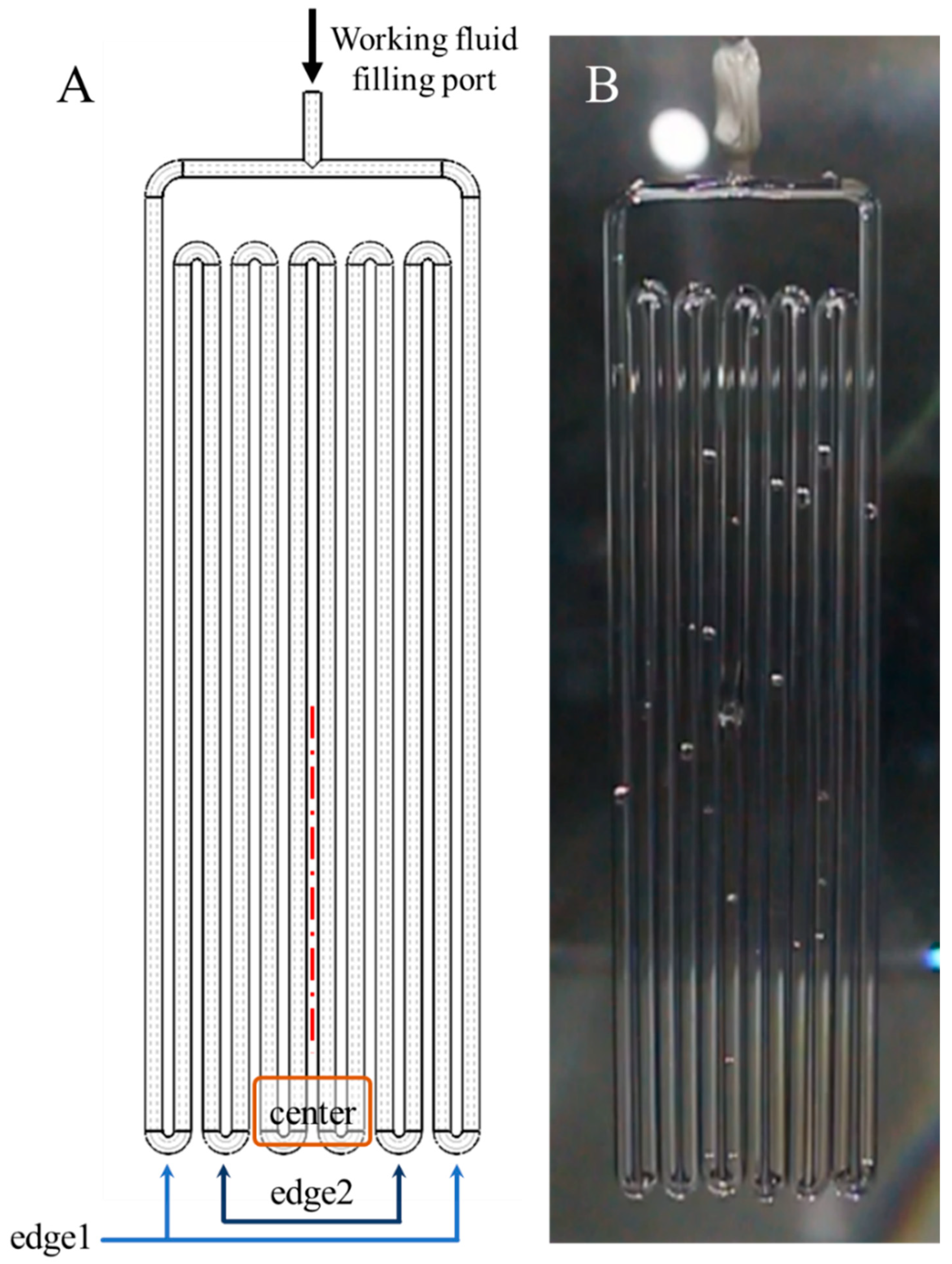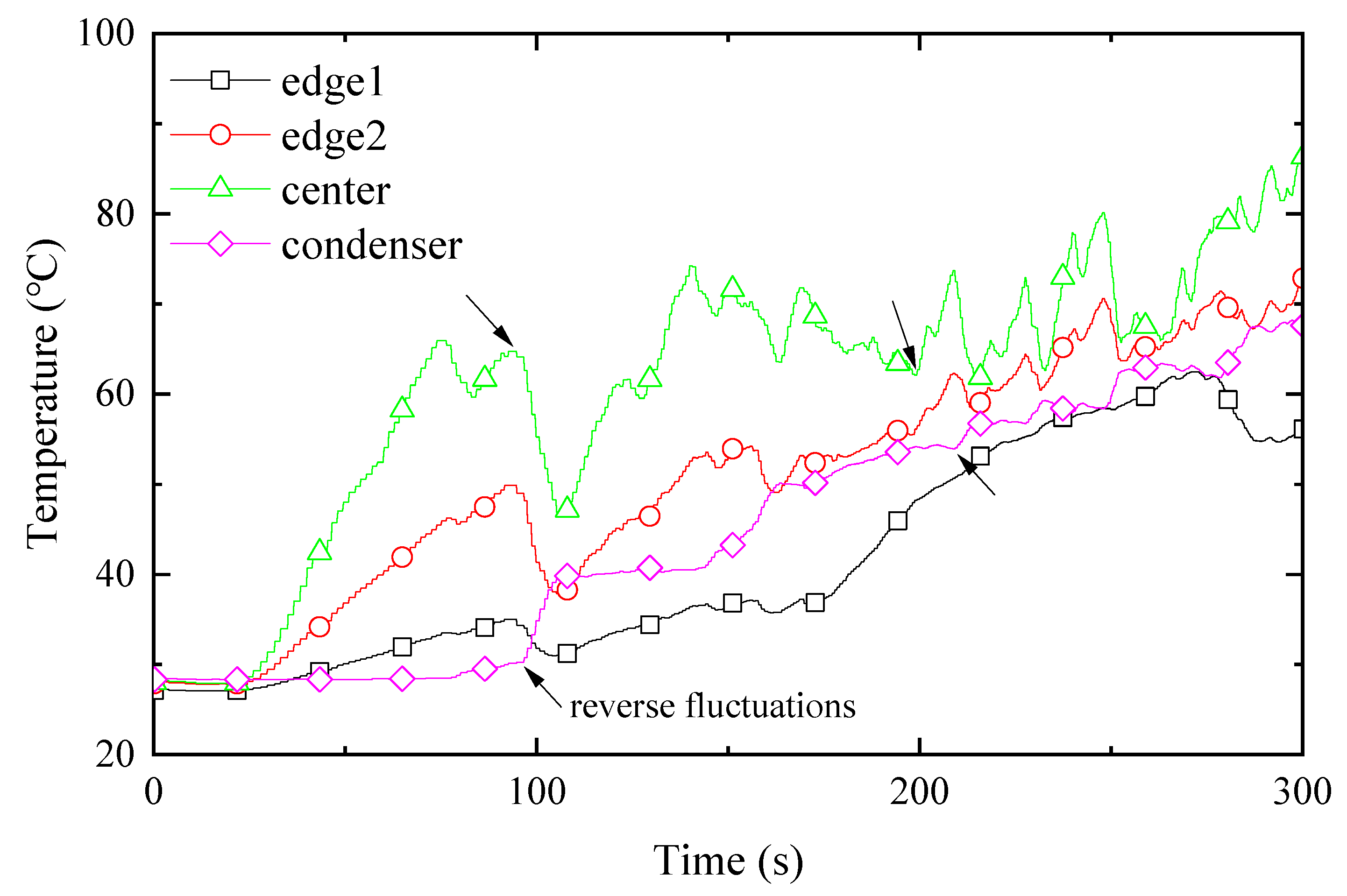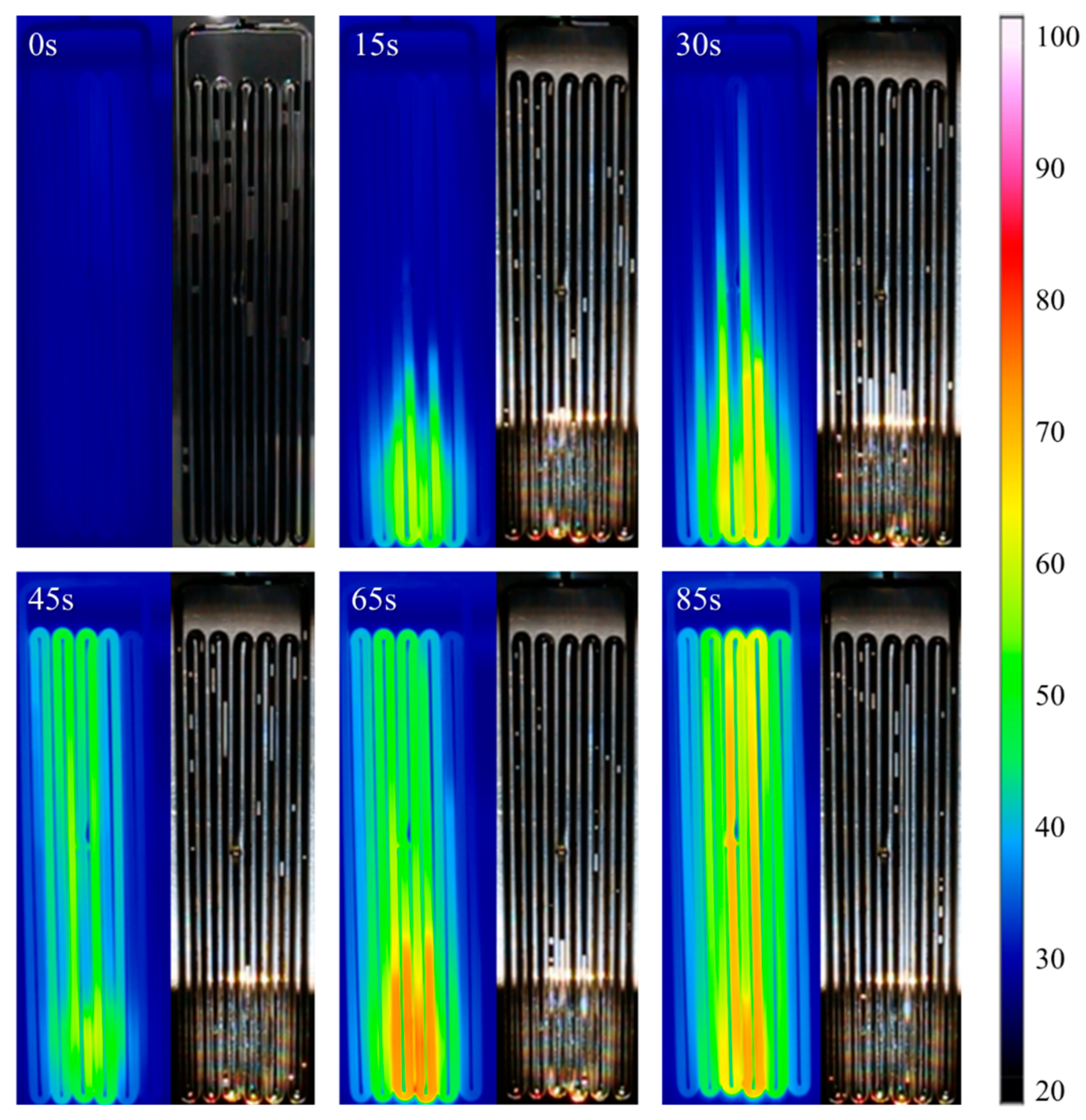Experimental Study of Pulsating Heat Pipes Filled with Nanofluids under the Irradiation of Solar Simulator
Abstract
:1. Introduction
2. Experimental System
3. Results and Discussion
3.1. Effect of Nanofluid Concentration
3.2. Heat Transfer Performance Analysis
3.3. Temperature Fluctuation and Quasi-Sine Oscillation Analysis
3.4. Gas Plugs Movement and Pumping Thrust Analysis
- (1).
- The size of the gas plugs for the DI water is generally small (there are no gas plugs longer than 3 cm), which leads to a large number of gas plugs in the PHP, as shown in the red rectangles in Figure 10A. In addition, the distribution of gas plugs presents a random state and is not affected by their location in PHP. For PHP filled with nanofluids, the number of gas plugs is smaller. As shown in the red rectangles in Figure 10B, there are both large-size gas plugs and small-size gas plugs and some extra-long bubbles can reach more than 10 cm. In the distribution of gas plugs, the large-size gas plugs often appear in the evaporation section and the adiabatic section, and the small-size gas plugs are usually located in the condensation section.
- (2).
- The gas plugs of the DI water hardly move. As shown in Figure 10A, even if the time scale is extended to minutes, the gas plug distribution in the PHP is almost unchanged. From 1 min to 4 min, there is indeed a displacement of the gas plugs. However, the displacement is extremely small, and no sudden acceleration of the gas plugs can be seen in the video. The average velocity of the gas plugs is approximately , which is almost negligible. The lack of working fluid flow in the PHP greatly limits its heat transfer performance. However, for the nanofluid, the gas plugs move violently. The gas plugs moving speed can reach 0.55 m/s.
- (3).
- For the nanofluid, as shown in Figure 10B, a small gas plug in the evaporation section grows rapidly from about 1 cm (N0) to more than 10 cm (N3) in only 0.3 s after being heated. At the same time, a gas plug that was originally located above the small gas plug was quickly pushed to the condensation section. As the gas plug reaches the condensation section and begins to release heat, the length of the gas plug gradually decreases, from about 10 cm to less than 1 cm. This process explains well why gas plugs in PHPs have a such distribution rule.
4. Conclusions
- When the nanofluid concentration is relatively low, the PHP under low-concentrated solar intensity cannot operate and the temperature variations are similar to that of the PHP filled with DI water. For a higher concentration, the performance of the PHP improves with the increase in nanofluid concentration.
- There is an optimal filling rate for the PHP to achieve the best heat-transfer performance, and the optimal filling rate is between 80 and 90%. The minimum thermal resistance reaches 0.157 K/W for PHP filled with 0.5 wt% MWCNTs nanofluid at the filling rate of 80%.
- The quasi-sine oscillating behavior is observed in the experiment, under the appropriate concentration and filling rate of nanofluids.
- For PHPs that will operate, the large-size gas plugs often appear in the evaporation section and the adiabatic section, and the small-size gas plugs are usually located in the condensation section due to the contraction and expansion of gas plugs in different sections. Further investigation should be focused on selecting proper nanoparticle type and concentration and optimizing the PHP structure to increase the energy efficiency. In addition, the system energy efficiency can be further investigated by focusing precisely on the output power of the condensation section.
Author Contributions
Funding
Institutional Review Board Statement
Informed Consent Statement
Data Availability Statement
Conflicts of Interest
References
- Tian, Y.; Zhao, C.Y. A review of solar collectors and thermal energy storage in solar thermal applications. Appl. Energy 2013, 104, 538–553. [Google Scholar] [CrossRef] [Green Version]
- Lewis, N.S. Research opportunities to advance solar energy utilization. Science 2016, 351, aad1920. [Google Scholar] [CrossRef] [PubMed] [Green Version]
- Gibb, D.; Ledanois, N.; Ranalder, L.; Yaqoob, H. Renewables 2022 Global Status Report; REN21: Paris, France, 2022. [Google Scholar]
- Lenert, A.; Wang, E.N. Optimization of nanofluid volumetric receivers for solar thermal energy conversion. Sol. Energy 2012, 86, 253–265. [Google Scholar] [CrossRef] [Green Version]
- Bertocchi, R.; Karni, J.; Kribus, A. Experimental evaluation of a non-isothermal high temperature solar particle receiver. Energy 2004, 29, 687–700. [Google Scholar] [CrossRef]
- Jin, H.C.; Lin, G.P.; Bai, L.Z.; Zeiny, A.; Wen, D.S. Steam generation in a nanoparticle-based solar receiver. Nano Energy 2016, 28, 397–406. [Google Scholar] [CrossRef] [Green Version]
- Slaman, M.; Griessen, R. Solar collector overheating protection. Sol. Energy 2009, 83, 982–987. [Google Scholar] [CrossRef]
- Akachi, H. Structure of a Heat Pipe. United States Patent U.S. 4,921,041, 1 May 1990. [Google Scholar]
- Ma, H.B.; Wilson, C.; Borgmeyer, B.; Park, K.; Yu, Q.; Choi, S.U.S.; Tirumala, M. Effect of nanofluid on the heat transport capability in an oscillating heat pipe. Appl. Phys. Lett. 2006, 88, 143116. [Google Scholar] [CrossRef]
- Zhang, Y.; Faghri, A. Advances and unsolved issues in pulsating heat pipes. Heat Transf. Eng. 2008, 29, 20–44. [Google Scholar] [CrossRef] [Green Version]
- Qu, W.; Ma, H.B. Theoretical analysis of startup of a pulsating heat pipe. Int. J. Heat Mass Transf. 2007, 50, 2309–2316. [Google Scholar] [CrossRef]
- Ma, H. Oscillating Heat Pipes; Springer: New York, NY, USA, 2015. [Google Scholar]
- Chen, Y.; He, Y.; Zhu, X. Flower-type pulsating heat pipe for a solar collector. Int. J. Energy Res. 2020, 44, 7734–7745. [Google Scholar] [CrossRef]
- Rittidech, S.; Wannapakne, S. Experimental study of the performance of a solar collector by closed-end oscillating heat pipe (CEOHP). Appl. Therm. Eng. 2007, 27, 1978–1985. [Google Scholar] [CrossRef]
- Kargarsharifabad, H.; Mamouri, S.J.; Shafii, M.B.; Rahni, M.T. Experimental investigation of the effect of using closed-loop pulsating heat pipe on the performance of a flat plate solar collector. J. Renew. Sustain. Energy 2013, 5, 013106. [Google Scholar] [CrossRef]
- Arab, M.; Soltanieh, M.; Shafii, M.B. Experimental investigation of extra-long pulsating heat pipe application in solar water heaters. Exp. Therm. Fluid Sci. 2012, 42, 6–15. [Google Scholar] [CrossRef]
- Balakin, B.V.; Stava, M.; Kosinska, A. Photothermal convection of a magnetic nanofluid in a direct absorption solar collector. Sol. Energy 2022, 239, 33–39. [Google Scholar] [CrossRef]
- Minardi, J.E.; Chuang, H.N. Performance of a “black” liquid flat-plate solar collector. Sol. Energy 1975, 17, 179–183. [Google Scholar] [CrossRef]
- Bandarra, E.P.; Mendoza, O.S.H.; Beicker, C.L.L.; Menezes, A.; Wen, D.S. Experimental investigation of a silver nanoparticle-based direct absorption solar thermal system. Energy Convers. Manag. 2014, 84, 261–267. [Google Scholar] [CrossRef]
- Zhang, H.; Chen, H.J.; Du, X.Z.; Wen, D.S. Photothermal conversion characteristics of gold nanoparticle dispersions. Sol. Energy 2014, 100, 141–147. [Google Scholar] [CrossRef]
- Khanafer, K.; Vafai, K. A review on the applications of nanofluids in solar energy field. Renew. Energy 2018, 123, 398–406. [Google Scholar] [CrossRef]
- Otanicar, T.P.; Phelan, P.E.; Golden, J.S. Optical properties of liquids for direct absorption solar thermal energy systems. Sol. Energy 2009, 83, 969–977. [Google Scholar] [CrossRef]
- Rahman, M.M.; Al-Mazroui, W.A.; Al-Hatmi, F.S.; Al-Lawatia, M.A.; Eltayeb, I.A. The role of a convective surface in models of the radiative heat transfer in nanofluids. Nucl. Eng. Des. 2014, 275, 382–392. [Google Scholar] [CrossRef]
- Hussain, I.; Graham, S.; Wang, Z.X.; Tan, B.; Sherrington, D.C.; Rannard, S.P.; Cooper, A.I.; Brust, M. Size-controlled synthesis of near-monodisperse gold nanoparticles in the 1–4 nm range using polymeric stabilizers. J. Am. Chem. Soc. 2005, 127, 16398–16399. [Google Scholar] [CrossRef] [PubMed]
- Hwang, S.H.; Yun, J.; Jang, J. Multi-Shell Porous TiO2 Hollow Nanoparticles for Enhanced Light Harvesting in Dye-sensitized Solar Cells. Adv. Funct. Mater. 2014, 24, 7619–7626. [Google Scholar] [CrossRef]
- Halas, N.J.; Neumann, O.; Urban, A.; Hogan, N.; Fang, Z.Y.; Pimpinelli, A.; Lal, S.; Nordlander, P. Solar Vapor Generation Enabled by Nanoparticles. Abstracts of Papers of the American Chemical Society. 2013. Available online: https://www.webofscience.com/wos/alldb/full-record/WOS:000329618406075 (accessed on 9 October 2022).
- Khullar, V.; Tyagi, H.; Hordy, N.; Otanicar, T.P.; Hewakuruppu, Y.; Modi, P.; Taylor, R.A. Harvesting solar thermal energy through nanofluid-based volumetric absorption systems. Int. J. Heat Mass Transf. 2014, 77, 377–384. [Google Scholar] [CrossRef]
- Jin, H.C.; Lin, G.P.; Bai, L.Z.; Amjad, M.; Bandarra, E.P.; Wen, D.S. Photothermal conversion efficiency of nanofluids: An experimental and numerical study. Sol. Energy 2016, 139, 278–289. [Google Scholar] [CrossRef] [Green Version]
- Jin, H.C.; Lin, G.P.; Zeiny, A.; Bai, L.Z.; Wen, D.S. Nanoparticle-based solar vapor generation: An experimental and numerical study. Energy 2019, 178, 447–459. [Google Scholar] [CrossRef]
- Neumann, O.; Urban, A.S.; Day, J.; Lal, S.; Nordlander, P.; Halas, N.J. Solar Vapor Generation Enabled by Nanoparticles. ACS Nano 2013, 7, 42–49. [Google Scholar] [CrossRef]
- Ni, G.; Li, G.; Boriskina, S.V.; Li, H.X.; Yang, W.L.; Zhang, T.J.; Chen, G. Steam generation under one sun enabled by a floating structure with thermal concentration. Nat. Energy 2016, 1, 16126. [Google Scholar] [CrossRef]
- Li, X.Q.; Xu, W.C.; Tang, M.Y.; Zhou, L.; Zhu, B.; Zhu, S.N.; Zhu, J. Graphene oxide-based efficient and scalable solar desalination under one sun with a confined 2D water path. Proc. Natl. Acad. Sci. USA 2016, 113, 13953–13958. [Google Scholar] [CrossRef] [Green Version]
- Zhou, L.; Tan, Y.L.; Ji, D.X.; Zhu, B.; Zhang, P.; Xu, J.; Gan, Q.Q.; Yu, Z.F.; Zhu, J. Self-assembly of highly efficient, broadband plasmonic absorbers for solar steam generation. Sci. Adv. 2016, 2, e1501227. [Google Scholar] [CrossRef] [Green Version]
- Lukianova-Hleb, E.; Hu, Y.; Latterini, L.; Tarpani, L.; Lee, S.; Drezek, R.A.; Hafner, J.H.; Lapotko, D.O. Plasmonic Nanobubbles as Transient Vapor Nanobubbles Generated around Plasmonic Nanoparticles. ACS Nano 2010, 4, 2109–2123. [Google Scholar] [CrossRef]
- Fang, Z.; Zhen, Y.-R.; Neumann, O.; Polman, A.; de Abajo, F.J.G.; Nordlander, P.; Halas, N.J. Evolution of Light-Induced Vapor Generation at a Liquid-Immersed Metallic Nanoparticle. Nano Lett. 2013, 13, 1736–1742. [Google Scholar] [CrossRef] [PubMed] [Green Version]
- Tullius, T.K.; Bayazitoglu, Y. Temperature of a metallic nanoparticle embedded in a phase change media exposed to radiation. Int. J. Heat Mass Transf. 2016, 93, 980–990. [Google Scholar] [CrossRef]
- Yu, S.; Zhang, Y.; Duan, H.; Liu, Y.; Quan, X.; Tao, P.; Shang, W.; Wu, J.; Song, C.; Deng, T. The impact of surface chemistry on the performance of localized solar-driven evaporation system. Sci. Rep. 2015, 5, srep13600. [Google Scholar] [CrossRef] [PubMed] [Green Version]
- Bae, K.; Kang, G.; Cho, S.K.; Park, W.; Kim, K.; Padilla, W.J. Flexible thin-film black gold membranes with ultrabroadband plasmonic nanofocusing for efficient solar vapour generation. Nat. Commun. 2015, 6, 10103. [Google Scholar] [CrossRef] [Green Version]
- Shannon, M.A. Water Desalination Fresh for Less. Nat. Nanotechnol. 2010, 5, 248–250. [Google Scholar] [CrossRef]
- Elimelech, M.; Phillip, W.A. The Future of Seawater Desalination: Energy, Technology, and the Environment. Science 2011, 333, 712–717. [Google Scholar] [CrossRef]
- Chen, X.; Munjiza, A.; Zhang, K.; Wen, D. Molecular Dynamics Simulation of Heat Transfer from a Gold Nanoparticle to a Water Pool. J. Phys. Chem. C 2014, 118, 1285–1293. [Google Scholar] [CrossRef]
- Baffou, G.; Quidant, R.; de Abajo, F.J.G. Nanoscale Control of Optical Heating in Complex Plasmonic Systems. ACS Nano 2010, 4, 709–716. [Google Scholar] [CrossRef]
- Donner, J.S.; Baffou, G.; McCloskey, D.; Quidant, R. Plasmon-Assisted Optofluidics. ACS Nano 2011, 5, 5457–5462. [Google Scholar] [CrossRef]
- Hou, L.; Yorulmaz, M.; Verhart, N.R.; Orrit, M. Explosive formation and dynamics of vapor nanobubbles around a continuously heated gold nanosphere. New J. Phys. 2015, 17, 013050. [Google Scholar] [CrossRef]
- Ni, G.; Miljkovic, N.; Ghasemi, H.; Huang, X.; Boriskina, S.V.; Lin, C.-T.; Wang, J.; Xu, Y.; Rahman, M.M.; Zhang, T.; et al. Volumetric solar heating of nanofluids for direct vapor generation. Nano Energy 2015, 17, 290–301. [Google Scholar] [CrossRef] [Green Version]
- Jin, H.; Lin, G.; Zeiny, A.; Bai, L.; Cai, J.; Wen, D. Experimental study of transparent oscillating heat pipes filled with solar absorptive nanofluids. Int. J. Heat Mass Transf. 2019, 139, 789–801. [Google Scholar]
- Jin, H.; Lin, G.; Guo, Y.; Bai, L.; Wen, D. Nanoparticles enabled pump-free direct absorption solar collectors. Renew. Energy 2020, 145, 2337–2344. [Google Scholar] [CrossRef]
- Moffat, R.J. Describing the uncertainties in experimental results. Exp. Therm. Fluid Sci. 1988, 1, 3–17. [Google Scholar] [CrossRef] [Green Version]
- Yin, D.; Rajab, H.; Ma, H. Theoretical analysis of maximum filling ratio in an oscillating heat pipe. Int. J. Heat Mass Transf. 2014, 74, 353–357. [Google Scholar] [CrossRef]










| DI Water | Ag 0.001 wt% | Ag 0.002 wt% | Ag 0.01 wt% | Ag 0.02 wt% | MWCNT 0.5 wt% | |
|---|---|---|---|---|---|---|
| 11.86% | 12.2% | 12.53% | 16.42% | 19.55% | 70.74% |
Publisher’s Note: MDPI stays neutral with regard to jurisdictional claims in published maps and institutional affiliations. |
© 2022 by the authors. Licensee MDPI, Basel, Switzerland. This article is an open access article distributed under the terms and conditions of the Creative Commons Attribution (CC BY) license (https://creativecommons.org/licenses/by/4.0/).
Share and Cite
Liu, S.; Yang, Y.; Ma, K.; Jin, H.; Jin, X. Experimental Study of Pulsating Heat Pipes Filled with Nanofluids under the Irradiation of Solar Simulator. Energies 2022, 15, 9153. https://doi.org/10.3390/en15239153
Liu S, Yang Y, Ma K, Jin H, Jin X. Experimental Study of Pulsating Heat Pipes Filled with Nanofluids under the Irradiation of Solar Simulator. Energies. 2022; 15(23):9153. https://doi.org/10.3390/en15239153
Chicago/Turabian StyleLiu, Shubo, Yi Yang, Kuiyuan Ma, Haichuan Jin, and Xin Jin. 2022. "Experimental Study of Pulsating Heat Pipes Filled with Nanofluids under the Irradiation of Solar Simulator" Energies 15, no. 23: 9153. https://doi.org/10.3390/en15239153
APA StyleLiu, S., Yang, Y., Ma, K., Jin, H., & Jin, X. (2022). Experimental Study of Pulsating Heat Pipes Filled with Nanofluids under the Irradiation of Solar Simulator. Energies, 15(23), 9153. https://doi.org/10.3390/en15239153







